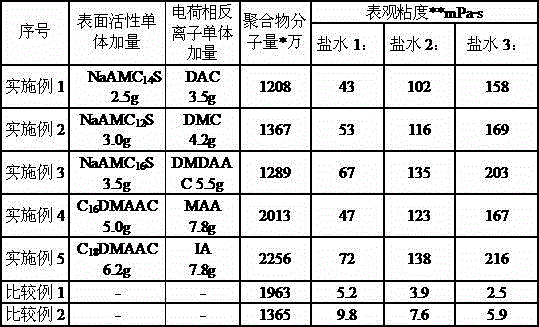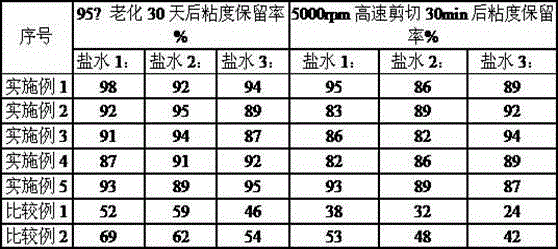Amphoteric hydrophobically-associating polymer and preparation method thereof
A hydrophobic association and polymer technology, applied in drilling compositions, chemical instruments and methods, etc., can solve the problems of temperature resistance, salt resistance and shear resistance that cannot meet the requirements of tertiary oil recovery, and achieve excellent viscosity increasing effect , Excellent temperature resistance and salt resistance, the effect of controllable molecular weight
- Summary
- Abstract
- Description
- Claims
- Application Information
AI Technical Summary
Problems solved by technology
Method used
Image
Examples
Embodiment 1
[0047] Add 2500g of deionized water to the reaction kettle, add 450g of acrylamide (AM), 200g of 2-acrylamido-2-methylpropanesulfonic acid (AMPS), 2.5g of sodium 2-acrylamidotetradecylsulfonate (NaAMC 14 S) and 3.5g of acryloyloxyethyltrimethylammonium chloride (DAC), neutralized to neutral with NaOH, then added 0.04g of disodium edetate, 7g of urea, 0.07g of isopropanol, and stirred until completely dissolved. Adjust the pH value to 8.5 with NaOH, and start to feed high-purity nitrogen gas. After 30 minutes, the temperature in the kettle was lowered to 15°C, and then 10 g of 0.2% sodium bisulfite aqueous solution, 0.5% methacrylic acid N,N-di 10g of methylaminoethyl ester (DMAEMA) aqueous solution, 10g of 0.5% azobisisobutylamidine hydrochloride, 10g of 0.3% potassium persulfate aqueous solution, continue to pass nitrogen gas for 30min and then seal. After 1 hour, the reaction temperature was gradually raised to 48°C. After 3.5 hours of reaction, a gel-like polymer product ...
Embodiment 2
[0054] First add 2500g of deionized water to the reaction kettle, add 500g of acrylamide (AM), 180g of 2-acrylamido-2-methylpropanesulfonic acid (AMPS), 3.0g of 2-acrylamido sodium dodecylsulfonate (NaAMC12 S) and 4.2g of methacryloyloxyethyltrimethylammonium chloride (DMC), neutralized to neutral with NaOH, then added 0.045g of disodium edetate, 7.0g of urea, and 0.06 of isopropanol g, stirred until completely dissolved. Adjust the pH value to 9.1 with NaOH, and start to feed high-purity nitrogen. After 30 minutes, the temperature in the kettle was lowered to 12°C, and then 10.6 g of 0.2% sodium bisulfite aqueous solution, 0.5% acrylic acid N,N-dimethyl Aminoethyl ester (DA) aqueous solution 12g, 0.5% azobisisobutylamidine hydrochloride 11g, 0.3% potassium persulfate aqueous solution 12g, continue nitrogen gas for 30min and then seal. After 1 hour, the reaction temperature was gradually raised to 52 ° C, and after 3 hours of reaction, a gel-like polymer product was obtained....
Embodiment 3
[0057] First add 2800g of deionized water to the reaction kettle, add 500g of acrylamide (AM), 120g of 2-acrylamido-2-methylpropanesulfonic acid (AMPS), 120g of acrylic acid, 3.5g of 2-acrylamido hexadecyl Sodium sulfonate (NaAMC 16 S) and 5.2g of dimethyl diallyl ammonium chloride (DMDAAC), neutralized to neutral with NaOH, then added 0.05g of disodium edetate, 8.0g of urea, 0.07g of isopropanol, and stirred until completely dissolved. Adjust the pH value to 8.8 with NaOH, and start feeding high-purity nitrogen gas. After 30 minutes, the temperature in the kettle was lowered to 20°C, and then 11.2 g of 0.2% aqueous sodium bisulfite solution, 0.5% acrylic acid N,N-dimethyl Aminoethyl ester (DA) aqueous solution 12.5g, 0.5% 2,2'-azo[2-(2-imidazolin-2-yl)propane] dihydrochloride 13g, 0.3% potassium persulfate aqueous solution 12g, Continue to pass nitrogen gas for 30 minutes before sealing. After 1 hour, the reaction temperature was gradually increased to 55°C. After 2.5 ...
PUM
| Property | Measurement | Unit |
|---|---|---|
| Apparent viscosity | aaaaa | aaaaa |
| Apparent viscosity | aaaaa | aaaaa |
Abstract
Description
Claims
Application Information
 Login to View More
Login to View More - R&D
- Intellectual Property
- Life Sciences
- Materials
- Tech Scout
- Unparalleled Data Quality
- Higher Quality Content
- 60% Fewer Hallucinations
Browse by: Latest US Patents, China's latest patents, Technical Efficacy Thesaurus, Application Domain, Technology Topic, Popular Technical Reports.
© 2025 PatSnap. All rights reserved.Legal|Privacy policy|Modern Slavery Act Transparency Statement|Sitemap|About US| Contact US: help@patsnap.com


